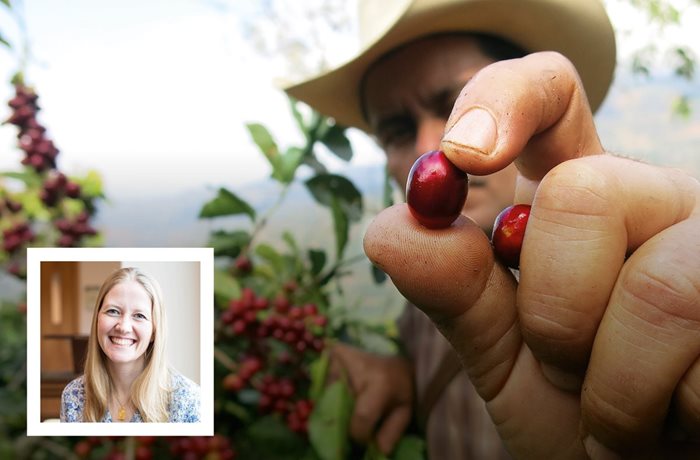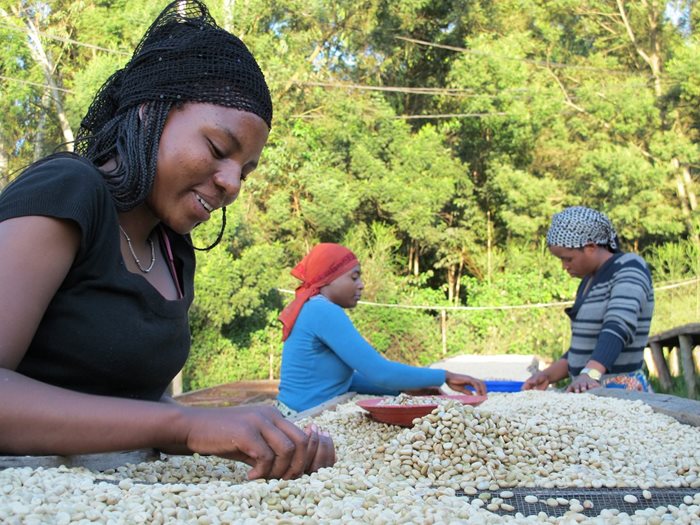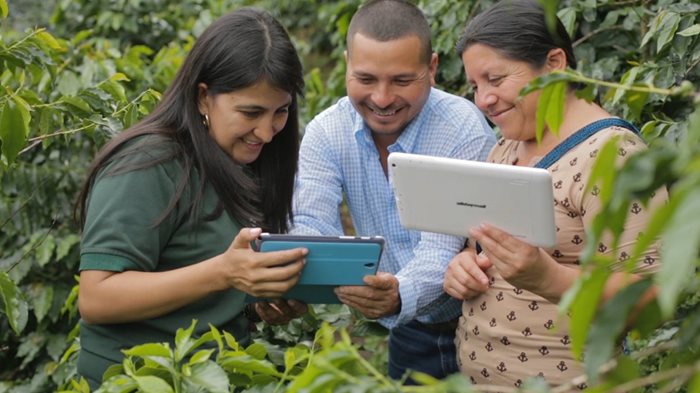5THWAVE caught up with Colleen Popkin, Coffee Sector Lead, Market Transformation at Rainforest Alliance, to discuss why building climate resilience at origin is also not only great for the planet, but makes great business sense for farmers too

Main image: A coffee farmer picking coffee cherries | Inset: Colleen Popkin, Coffee Sector Lead, Market Transformation at Rainforest Alliance | Photo credits: All photos courtesy of Rainforest Alliance
What impacts does coffee farming have on the environment?
The way coffee is grown can have a significant impact on the local ecosystem. Like most agricultural production, coffee farming can harm water, land, and animal life if it is not grown with environmentally friendly practices, for example, to reduce the use of pesticides or to treat wastewater from the wet-milling process. But coffee farming can also have a beneficial impact on the environment too – especially compared with other land uses – given that it is a perennial tree crop that grows well under shade. At
Rainforest Alliance, we work with coffee farmers to minimise the potential negative impacts to the environment, and maximise the potential positive ones.
What impact is the climate emergency having on global coffee production?
Coffee likes a predictable pattern of temperature and rainfall, and therefore it is highly vulnerable to the impacts of climate change. As temperatures rise, farmers face new pests and diseases.
Coffee becomes less suitable in the places it is grown today and must shift to new areas – potentially further uphill into areas that were formerly forest. As weather patterns change, and climate-related shocks become more common, this will impact the quality and availability of coffee. According to
estimates by World Coffee Research, half of the land currently suitable for Arabica coffee production will no longer be suitable by 2050.
But we are also seeing the impacts today. The International Coffee Organization (ICO) predicts a substantial reduction in world coffee volumes this year due to recent climate-related shocks, such as the frost event in Brazil – the world’s largest coffee producer.
It’s up to all of us to create the future we want – and that involves changes big and small in many areas of our lives
How is Rainforest Alliance working with coffee farmers to solve these challenges?
The Rainforest Alliance works with coffee farmers to become more climate resilient. Through our certification and our field programming, we promote more sustainable farming practices that help producers mitigate and adapt to climate impacts – for example, through increasing shade cover to lower temperatures and improving soil moisture through mulching. We support practices that not only are environmentally friendly, but also increase productivity of the farm and the quality of the bean. These on-farm efforts, combined with access to differentiated markets that co-invest with producers, improve profitability which is key to climate resilience as well.
Producers need real financial incentives for this hard work and investment they are bringing to their farms. And they need a nest-egg so they can withstand climate shocks that are becoming increasingly frequent.
How is the 2018 merger with UTZ enabling Rainforest Alliance to better achieve its goals?
Our single programme – the 2020 Rainforest Alliance certification programme – has combined the strengths and scale of the two leading organisations in coffee certification. Across both programmes, in 2020, we worked with over 400,000 farmers, covering an area of over one million hectares in 28 countries. The scale of our combined organisation now reaches more farmers and landscapes, helping us better achieve our mission. Practically, this means that farmers and other supply chain actors can invest more efficiently in sustainability, accessing larger markets and streamlining their efforts, avoiding a double administrative workload of two standards and certification systems.

Coffee sorters in Rwanda
How can coffee businesses and individuals in coffee-consuming markets support social and environmental sustainability in producing countries?
It’s up to all of us to create the future we want – and that involves changes big and small in many areas of our lives. Businesses and individuals need to know that their purchasing decisions and other actions can contribute to a world where people and nature can thrive in harmony.
For coffee businesses and coffee drinkers, there are third-party sustainability certifications – like the Rainforest Alliance – that help link them to farmers and processors who are committed to social and environmental standards. By looking for the Rainforest Alliance green frog on your coffee, or asking questions about how the coffee gets sourced, you can help to advance sustainable agriculture, improve the living conditions for farmers and their families while protecting forests, wildlife, and the environment for future generations.
Can you share some of your environmental success stories with coffee-growing communities?
Research shows that certified farmers implement more sustainable practices that can help them adapt to and prepare for climate impacts. The 1,000-hectare Aquiares Estate Coffee in Costa Rica, which sits between the country’s largest protected area and a volcanic mountain range, is a stellar example of how farming practices designed to boost biodiversity and nourish soil can restore the overall health of an ecosystem.
General Manager
Diego Robelo says that since the farm began its sustainability transformation with the Rainforest Alliance 17 years ago, it has gone from using a full-sun monoculture approach to cultivating coffee under the shade of native trees.
As the largest Rainforest Alliance Certified coffee farm in Costa Rica, Aquiares has been a pioneer in applying regenerative principles on a grand scale, planting more than 50,000 trees and effectively connecting two important wildlife corridors. Now the farm boasts 76 different native tree species and 140 bird species – 103 of which hadn’t been seen before Aquiares began working with the Rainforest Alliance.

The Farmer Training App helps coffee farmers adapt to climate change
But the Rainforest Alliance’s strategy goes beyond certification to achieve our mission. We also contribute to broader landscape management. The Rainforest Alliance created a ground-breaking climate-smart
agriculture guide for Peruvian cocoa and coffee farmers based on advanced climate modelling by scientific organisation Center for Tropical Agriculture (CIAT), under the Consultative Group for International Agricultural Research (CGIAR), with support from Climate Change, Agriculture, and Food Security (CCAFS).
The guide starts with methods for assessing local conditions to determine appropriate responses. Detailed instructions cover topics like pruning techniques and the use of simple solar dryers to deal with increased moisture (a challenge for coffee plants and coffee drying). The guide, created with data collected over 13 years, is specifically for cocoa and coffee landscapes in Peru, but it also includes information on good practices for other crops.
The Rainforest Alliance is constantly innovating to help people and nature thrive in harmony.
The Farmer Training App was introduced to help coffee farmers adapt to climate change. The app connects farmers to our extensive climate-smart agriculture training modules, which can be downloaded while in signal range and used offline. The app also enables farmers to share tips, videos, and photos with one another – and build a growing web of knowledge and skills to build resilience to climate change, promote food security, and advance best practices in sustainable agriculture.
This was piloted in 2015 with a cooperative of smallholder coffee farmers who live in a remote, rural area in the Western Highlands of Guatemala. Farmers and community leaders received training in how to operate the app, download information, and upload photos and stories of their own. With the simplest of tablets or smartphones, a farmer can watch videos on improving productivity, waste management, wildlife conservation, and more.
This ingeniously simple, low-cost technology is accessible to everyone, regardless of age or gender. And because the information is presented in videos, photos, and graphics, farmers of all literacy levels can use the app too. Furthermore, it is designed so that once it’s downloaded, it can run offline. A farmer in a remote area without internet can visit the cooperative office or town centre to download, then carry the tablet out to his or her coffee plot.
This article was first published in Issue 8 of 5THWAVE magazine.
Subscribe to 5THWAVE to receive each edition in print and digitally or sign up to our newsletter and be the first to read the latest articles and updates on World Coffee Portal research
